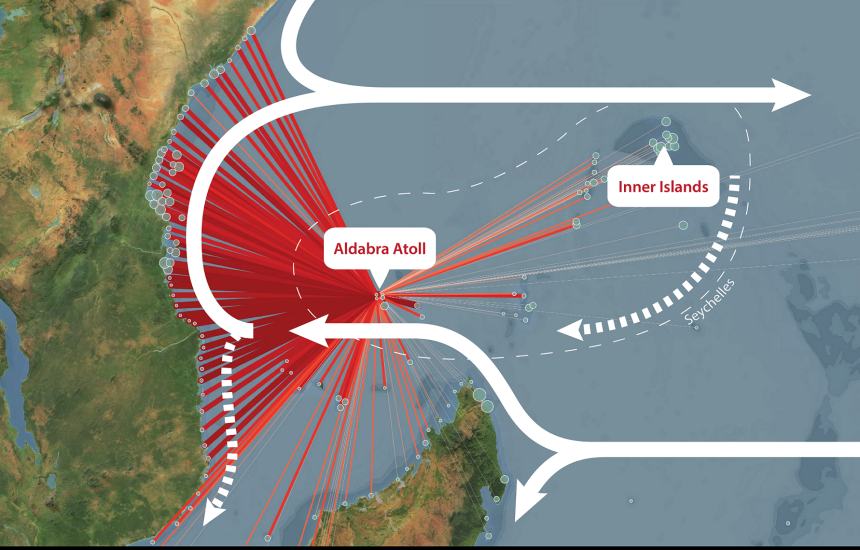According to a recent study, distant coral reefs in the Seychelles are intimately connected despite being dispersed over a million square kilometers. Oxford University researchers have shown for the first time that a network of ocean currents acts as a “coral superhighway,” dispersing a significant number of larvae across these far-off islands. They did this by using genetic analysis and oceanographic modeling. Nature Scientific Reports reported these findings.
 Map of the southwest Indian Ocean, with red lines connecting Aldabra Atoll, Seychelles, to simulated downstream coral larval destinations, primarily in East Africa. Solid white arrows show major current systems, dotted white arrows show minor or transient currents. The new study suggests that strong connectivity within Seychelles is established clockwise, potentially traveling between the Inner Islands and remote Aldabra Group via reefs in East Africa, and centrally located reefs within Seychelles. Image Credit: Dr Noam Vogt-Vincent
Map of the southwest Indian Ocean, with red lines connecting Aldabra Atoll, Seychelles, to simulated downstream coral larval destinations, primarily in East Africa. Solid white arrows show major current systems, dotted white arrows show minor or transient currents. The new study suggests that strong connectivity within Seychelles is established clockwise, potentially traveling between the Inner Islands and remote Aldabra Group via reefs in East Africa, and centrally located reefs within Seychelles. Image Credit: Dr Noam Vogt-Vincent
This discovery is very important because a key factor in coral reef recovery is larval supply. Although corals have declined alarmingly across the world due to climate change and a number of other factors, actions can be taken at local and national scale to improve reef health and resilience.
Dr April Burt, Researcher, University of Oxford
Dr Burt added, “These actions can be more effective when we better understand the connectivity between coral reefs by, for instance, prioritizing conservation efforts around coral reefs that act as major larval sources to support regional reef resilience.”
To gather coral samples from 19 distinct reef locations, the researchers worked with the Seychelles government and a variety of coral reef management organizations. All sample sites showed recent gene flow, probably within a few generations, according to a thorough genetic study, indicating that coral larvae may regularly migrate across populations.
The findings also suggested the possibility of a new, obscure species of Porites lutea, a common bouldering coral.
Genetic investigations were then combined with oceanographic modeling to simulate the process of larval dispersal. These simulations enabled researchers to visualize the paths coral larvae use to move across reefs across the region, as well as evaluate the relative relevance of physical larval dispersal versus other biological processes in establishing coral connectivity.
This indicated that coral larvae migration between reefs in the Seychelles is extremely likely. Coral larvae produced on the isolated Aldabra atoll, for example, might travel westward along Africa’s east coast via the East African Coastal Current. From here, they would go north along the coast, maybe even reaching the South Equatorial Counter Current, which would take them eastward back to the Inner Islands of Seychelles.
While long-distance dispersion events are feasible, it seems expected that much of the connection between isolated islands in the Seychelles will be formed via ‘stepping-stone’ dispersal. This shows that centrally positioned coral reefs in the Seychelles, and maybe East Africa, could play a critical role in connecting the most isolated islands.
This research suggests that the broad agreement between predicted connectivity and observed genetic patterns supports the use of such larval dispersal simulations in reef system management in Seychelles and the wider region. These simulations also allow us to investigate how regular these connectivity patterns are in time, because a regular larval supply will be essential for reef recovery in the face of climate change.
Dr Noam Vogt-Vincent, Department of Earth Sciences, University of Oxford
The modeling data can be shown in a new app: with a single click, users can see how coral larvae from Seychelles might reach reefs around the area. The researchers believe that this information might assist in identifying key larval sources that should be prioritized for inclusion in marine protected areas or active reef restoration operations.
Dr Joanna Smith and Helena Sims (The Nature Conservancy) who support the Seychelles Marine Spatial Plan Initiative stated, “The WIO coral connectivity study, by illustrating the connectivity of reefs within a network, can be used at national and regional scales in the Western Indian Ocean for Marine Protected Area design and management, as well as directing restoration activities. We look forward to using the results and Coral Connectivity app to inform implementation of the Seychelles Marine Spatial Plan.”
Journal Reference:
Burt, A. J., et. al. (2024) Integration of population genetics with oceanographic models reveals strong connectivity among coral reefs across Seychelles. Nature Scientific Reports. doi:10.1038/s41598-024-55459-x